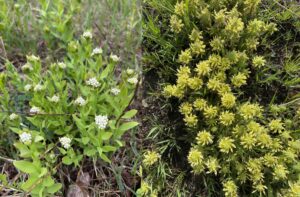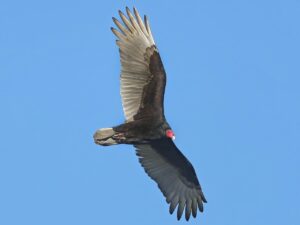By Kennedy Zittel, naturalist
Red-winged blackbirds are a common sight and sound of the marsh here at Woodland Dunes during the warmer months. Males can be seen sitting atop cattail stalks with their dark feathers and bright red and yellow wing-patches. Females are a streaky brown color and often stay lower to the ground. Their “Vote for me!” call can be heard echoing across the marsh.
 There can be up to 15 females per 1 male’s territory, and both males and females will defend their nest and space from threats. The females build their nest close to the ground by winding plant material around several upright stems (like cattails). They then add wet leaves and mud to the sides and line it with dried grass. With the marsh being full of nesting red-winged blackbirds, it is no wonder that you are sure to see them when you head out on Cattail Trail!
There can be up to 15 females per 1 male’s territory, and both males and females will defend their nest and space from threats. The females build their nest close to the ground by winding plant material around several upright stems (like cattails). They then add wet leaves and mud to the sides and line it with dried grass. With the marsh being full of nesting red-winged blackbirds, it is no wonder that you are sure to see them when you head out on Cattail Trail!
Besides being a summer birding staple of the preserve, red-winged blackbirds unknowingly help teach at our programs, too! One example of this happens during our 4K spring program. Part of the program has the kids going with us on a walk down Cattail Trail to look and listen for signs of spring. The kids love the nature walk, giggling and smiling ear to ear over frogs croaking, geese swimming in the pond, and those funny-looking “hotdog plants!” (cattails).
While looking and listening for signs of spring we point out the striking-looking red-winged blackbirds in the marsh and tell the kids that they are singing “Vote for me!”. We then tell the kids that if we sing to the birds they just might sing back to us! Eyes wide with shock they are ready to try to see if a real wild bird will sing to us! Now as you can imagine it is a bit tricky to get a group of 4- year olds to wait to the count of three… but we go… 1…2…3… “Vote for me!”
A few seconds go by, then we hear “Vote for me!” echoing back to us in the distance. Jumps for joy and shouts of “can we do it again!?” showcase a clear example of a nature- spark moment! Just this one simple interaction made them excited about nature, even the kids who were too shy to want to do it the first time eagerly sang to the red-wings when we called again.
This excitement about nature at an early age is exactly what we hope for. Excitement about nature leads to wanting to learn more, which leads to wanting to protect and care for the environment in the future. You never know what that nature-spark moment can be for a child, whether it is a bird call, a frog hopping across the trail, a shiny bug under a hand lens, or a flower that is “my absolute favoritest color ever!” out along the trail.
Getting to be a part of those magical encounters is one of my favorite parts of teaching. The look of pure excitement over things that we adults may take for granted is a good reminder to stop and take a second to really look at the world around us. To look for all of the wonderful things there is to experience out in nature.
photo of Red-winged blackbird by Cornell’s All About Birds





